HMS Calliope Crew Stories of the men present at Samoa during the Hurricane.
The majority of the following information has been provided by visitors to the site, with just a few details gleaned by me during my research. If you would like to have details about your own ancestor included (or amended), please
contact me me with the data.
I have not tried to maintain an order of seniority in the list, but rather used an alphabetical index on the surname. The rank is as quoted in the Crew List for the men at the time of the 1889 Apia hurricane. Where a source can be considered fairly accurate (family members, etc) then I have indicated my thanks. If there is no such acknowledgement, the information is what I have gleaned from my research and should be independently verified before being repeated.
Please Note: Any visitors to this site who object to the images of family members being portrayed, please contact me and I will remove the images, and /or the details, immediately.
Where there is a photograph of a crew member, please DO NOT use the image for anything at all, without first asking my permission using the contact form. If I do not know the family contact, then I will not be able to give permission for its use. If I do know of a family contact, I will ask them if they give permission, so in the contact form, please give details of how and why you wish to use the image. If they are agreeable, or indeed if not, I will then reply to your enquiry. This is not intended to be awkward or unfriendly, I think it is simply good courtesy to ask first.
Navigating this page
Page or scroll down to get to the table, which starts as full width to maximize the data on it, or use the quick-links below. The selected name will appear at the top of the window (except for those at the bottom of the list).
To anyone researching their family history who had seamen in the Royal Navy, the
National Archives at Kew have microfilms of most records of the nineteenth century in their reference series ADM188, and Officers in ADM196. Last time I visited, I viewed and printed my own great-grandfather's record which lists such things as Date of Birth, physical appearance, ships served on and periods, rating, conduct and so on. It is fascinating stuff. Although you cannot view the actual record on the internet, you can search for your ancestor, and if you find the right one you can buy a print over the net. As of July 2016 it was £3.45. These are the easiest methods I found:
Seaman's Records Go to the site using this link: ADM188 Search Listing. Enter your person's name, and if you have it, a date range (based on entry to the navy) and click the "search" button. Hopefully you will get a single entry with a reference number. (There may be more than one record for your ancestor). Click the title link and it will take you to the page where you can order the document.
Officer's Records Go to the site using this link: ADM196 Search Listing. Scroll down to about the middle of the page, enter your person's name, and click the "search" button. Hopefully you will get a single entry with a reference number. (There may be more than one record for your ancestor). Click the title link and it will take you to the page where you can order the document.
The page does state you can "View Images" of the record on-line, but they are deliberately distorted.
Crew Stories
Stoker William Burton Alsford
Born in 1870 and died around 1949. He ended his service in the Royal Navy as a Leading Stoker in 1904 while serving in HMS Narcissus following which he married & settled down in Lancaster Rd. in Southsea moving later to Lovedean, a small village just outside Portsmouth & finally to Durham St. in Portsmouth. After leaving the Navy he worked in the Dockyard until he retired.
Details courtesy of Joan Wilkinson.
Ordinary Seaman Joseph Attwell
Born 14 April 1870 at Fareham, Hants. Enlisted 1888 at age 18 for 12 years. Joined Royal Fleet Reserve Portsmouth in 1901 after completion of his first enlistment. He served on many ships including Royal Oak and Excellent. It looks as if he then enlisted for two more 5 year stints which took him through WW I. Some of his WW I time may have been on concrete ships.
Details courtesy of Kit Doan.
Able Seaman (General Service) James R. Baldrey
This gentleman was one of the sailors portrayed in the Radio Times play about the hurricane. So I guess he played an important part in Calliope's escape. See also William Miller. James was played by a Francis Lunt. He joined the navy as a boy aged 16 in February 1882, and served on HM Ships
Impregnable, Boscawen, Minotaur, Volage, Duke of Wellington, Calliope, Mildura, Curacoa and Pembroke. Born St Michael at Thorne, Norwich and formerly a shoemaker, of height 5'2", brown hair, grey eyes, fresh complexion with a scar on his chin. Received mostly "Very Good" character ratings, he did spend 14 days in gaol whilst serving on HMS
Curacoa for an undisclosed misdemeanour.
See the Radio Times, "Programme Listing".
Ordinary Seaman Joseph James Barber
Came from Poole in Dorset. Possibly listed in error as James Baker in the Calliope crew list. Joined Calliope from Orlando (possibly on loan). Joined navy in 1886. Served in H.M.S. Orlando transferring to Calliope on 20th January, 1889. Transferred to H.M.S. Egeria on the 23rd April 1889.
Details courtesy of Mike & Susan Hill.
Sick Bay Steward 2nd Class Sidney Barend
Sidney Barend was born in Hackney, Middlesex about 1861. He joined the RN as a domestic 3rd class in June 1879 aged 18. He was 5'6" tall with dark brown hair, brown eyes and a dark complexion. His trade was given as "Clerk".
The main vessels he served on were: Rifleman 1881-84 Asst SBA; Amethyst 1884-85 SBA / SBS 2nd Class; Clyde 1885-87 SBS 2nd Class; Calliope 1887-90 SBS 2nd Class (Samoan hurricane); Rodney 1890-93 SBS; Hood 1893-96 SBS; President 1897-01 SBS (Shore pensioned); Pembroke 1 1914-17 SBS; Thalia (Aberdeen) 1917-18 SBS; Nairn 1918-19 SBS Demobilised.
Barend's service record shows he was recommended for his LS and GC medal whilst aboard Calliope ("Traced Medal 18.11.89") but the same note was also made 8 months later on 24.7.90 when he was serving on HMS Pembroke and it was to this latter ship that his LS and GC medal was named (naming "S. BAREND 2ND SK B:STEWD: H.M.S. PEMBROKE."). It is unclear why two traced medals notes are on his service record. The Times reported his LS award in September 1890. Pensioned off from the RN in 1901, Barend rejoined in August 1914 after the outbreak of WW1. He served on Pembroke 1 (Chatham shore based establishment) for three years before joining HMS Thalia (depot ship Aberdeen). He ended his war service aboard HMS Nairn (an armed steam yacht used as a local patrol boat). For his WW1 service he was later awarded the BWM named to "108779 S BAREND. S.B.S. R.N."
Family Life : Sidney Barend married Minnie in Scotland in 1886 - they had a daughter Edith (born in Scotland in 1899). They were living In South Leyton, Essex at the time of the 1901 census but had moved back to Scotland by the time of the 1911 census. After the war Sidney seems to have remained in Scotland - dying in 1942 at the age of about 82.
Details courtesy of "Jon & Cyd".
Able Seaman (General Service) Willie Bennett
He was born in 1870 in Portsea, Portsmouth and served until 1899. It seems his main occupation was as "shop boy" before joining up. One of Willie Bennett's forebears was a Peter Bennett who was supposed to have sailed with Captain Cook on his 2nd and 3rd Voyages of discovery on HMS Resolution.
Details courtesy of Patrick Harris.
Chief Engineer (later Fleet Engineer) Henry George Bourke
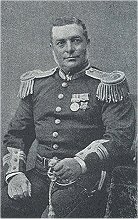
Born 24 October 1844 in Devonport, the only child of Michael Bourke, an Irish seaman,(rising to quartermaster) and his wife Mary Ann Odgers of Plymouth. He married Amelia Campbell, daughter of an Irish coastguard who had several postings in England. Fleet Engineer Bourke's Career details are: Asst. Eng. 1st Class 27 Oct 1867. 19 Sep 1869
TAMAR, troopship 2812 tons various ("particular" service). Engineer 19 Jul 1871. 30 Oct 1872
MOSQUITO gunboat 408 tons China. 15 Sep 1876 WARRIOR-Reserve-coastguard ship Portland. 14 Sep 1878
URGENT-depotship for gunboat service Jamaica. 2 Mar 1882
SULTAN battleship 9290 tons Channel Sqn. Chief Engineer 16 Oct 1883. 29 Nov 1883
OSPREY sloop East Indies. 16 Aug 1886
CALLIOPE corvette 2770 tons Portsmouth. Staff Engineer 16 Oct 1887 Still on
Calliope Australia. Fleet Engineer 28 May 1889 accelerated promotion after storm. (Dec 1889)
Calliope still returning home. 26 Nov 1890
HERO battleship-tender to Portsmouth
EXCELLENT. 2 Dec 1893
HERCULES battleship (Reserve) Portsmouth. 1 Jan 1896
VICTORY Portsmouth. 5 Mar 1898 Died in RNH Haslar of pneumonia.
Details courtesy of Shelagh Gibson. The photo was taken in Sydney, most probably April 1889.
Midshipman (later Captain) Frank Brandt
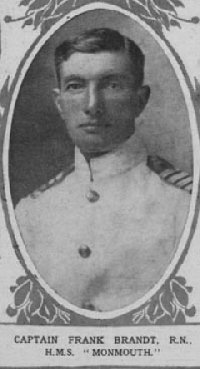
Born October 2nd, 1871. Died: November 1st, 1914. Captain Frank Brandt commanded H.M.S.
Monmouth in the battle of Coronel off the coast of Chile and perished in the ship which was lost with all hands. Brandt seems to have been born in Cheltenham, though his widow (Beryl) was quoted as living in Worthing. His parents were Francis Brandt, I.C.S. (Judge in the High Court, Madras), and Lucy Sophia (nee Dobson). His name is recorded on the Plymouth Naval Memorial, Devon. He and his sister Ethel spent much of their early years with an Aunt, Miss Emily Charlotte Brandt at her home Saint Roque in Torquay. Frank's grandson was the late Admiral Sir Hugo White.
Details courtesy of Kay Saville-Smith.
If you are interested in the Battle of Coronel, please visit this site: Battle of Coronel. Sadly, I discovered in July 2007 that the web-master for a fully dedicated site including crew names and a wonderful character sketch of Frank Brandt penned by his great-granddaughter, has disappeared. Unfortunately, much excellent data about the men involved appears to have been lost. This is the original link in case it ever becomes resurrected:www.coronel.org.uk
Lieutenant (Later Rear Admiral) Arthur William Carter

ARTHUR WILLIAM CARTER 1856-1931 was a son of Rev. Thomas Garden Carter, Vicar at Linton in Kent, and his wife Louisa (Turner). An extract from "The Linton Estate: the property of Messrs Carter Bros." in The Pastoral Review, Sydney, c. 1909 reads:
[He] joined the Navy on the 15th January 1870, was promoted sub-Lieutenant on 20th June 1875, Lieutenant 13th December 1879, Commander 1st January 1894, Captain 30th June 1899, retiring with the rank of Captain on 28th January 1905. He was appointed Rear-Admiral on the retired list on 5th November 1908. He served with the Naval Brigade in the Soudan [along with many future
Calliope shipmates including Captain Kane and WIT - Scaramouche]
, with the Nile Expedition for the relief of General Gordon 1884-5, and received the Egyptian medal with Nile clasp and Khedive's Grand Star. He was Lieutenant on the "Calliope" on the occasion of the great hurricane at Apia in 1889, when that vessel, by a splendid piece of seamanship on the part of her crew, escaped the fate of most of the other warships then in the harbour. The Admiralty expressed admiration at the officers' behaviour on that occasion, and specially referred to Lieutenant Carter. He retired from the Navy in order that he might assist his brother in the management of their joint property [in northern New South Wales].In 1911, he and his wife Monica returned to Bournemouth, England where they both died in 1931.
Image and details including the quoted extract courtesy of Jane Hunt.
Ordinary Seaman Ernest Jesse Denyer
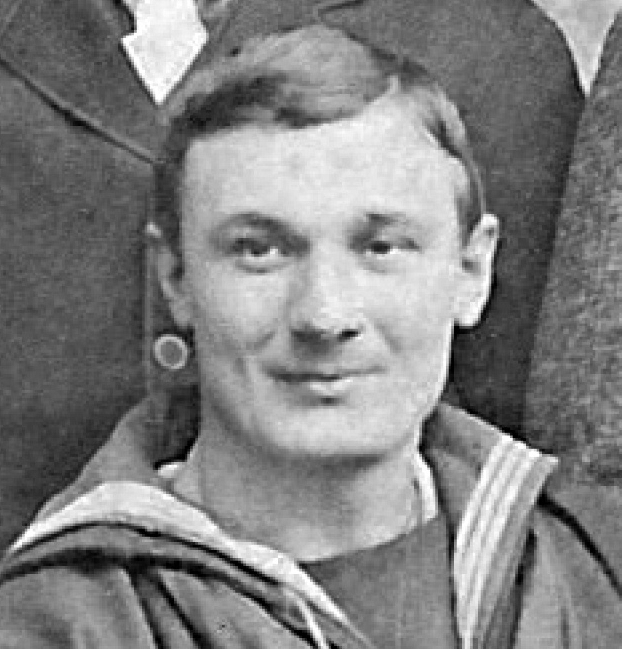
Ernest was born in Selsey, Chichester, Sussex. He seems to have joined the navy for 12 years on his 18th birthday, 18th April, 1889, but that is usually the date of his actual service, most people having joined earlier as a boy, possibly in his case on 2nd February 1886. He initially served on HMS
Impregnable, followed by a long list of ships:
Ganges, Impregnable again, Thalis, Nelson, Calliope, Duke of Wellington, Volage, Excellent, Vernon, Excellent again, Victory I, Trafalgar, Victory I again, Inflexible, Victory I again, Edinburgh, Excellent again, Edinburgh again, Vernon again, Edinburgh again, Rodney, Victory I again, Terrible, Vernon again, Tamar, Albion, Tamar again, Firequeen II, Barfleur, Naiobe, Empress of India, Victory I again, Vernon again, Victory I again, Pandora, Victory I again, Victory II, Volage(?) again, and was pensioned off from HMS
Victory I which he left in April 1911. It is most likely that those ships which he joined from a vessel such as HMS
Edinburgh to HMS
Vernon and back to HMS
Edinburgh, were temporary detachments to training ships attached to the former.
HMS
Empress of India sounds like a passenger ship, but was one of seven Royal Sovereign-class pre-dreadnought battleships built for the Royal Navy during the 1890s.
In 1909 and apparently at the time of Czar Nicholas and his Czarina Alexandria on their visit to the Great Spithead Naval review in that year, he was awarded the "Russian Silver Medal of St Stanislas". This appears to be a prestigious honour, refer to
Order of Saint Stanislaus. Shortly after leaving the Royal Navy, Ernest emigrated to St John, New Briusnwick, Canada in 1911, where he died in 1942.
The image is part of a photograph of Ernest taken c.1904. The full image shows his uniform badges, which are "Chief Petty Officer, Gunner's Mate" on the right arm, and the single chevron on his left indicating at least 5 years Long Service and Good Conduct.
Details and image courtesy of Doris Richardson.
Midshipman (later Vice Admiral) Sidney Robert Drury-Lowe C.M.G.

Born 19th October, 1871. Died January 1945. Was Captain of HMS
Chatham when she discovered and shelled the German raider
Koenigsberg about six miles up the Rufigi River Delta, opposite Mafia Island (German East Africa) in October 1914.
Details from Royal Navy Officer's service record, National Archives at Kew.
Fleet-Surgeon Valentine Duke, B.A., M.B.
Born County Meath, Ireland. Promoted to Assistant Surgeon on 7th September 1867. Appointment to the Navy List June 1870. Promoted to Staff Surgeon on 20th December 1878. Promoted to Fleet-Surgeon sometime prior to 1888. Possibly his father and grandfather shared not only his exact name, but also his profession.
Details from the web which due to the somewhat unusal name seems very likely to apply to the gentleman on HMS Calliope but I am not absolutely certain.
Steward Michael Finnie
Michael Finnie, was born in Queenstown (now Cobh), County Cork in Ireland, on 23rd September 1871. Queenstown was then a major British naval base, and a centre for trans-Atlantic passenger services. Like many young men in Queenstown, a career in the Navy was an obvious choice. His father, Alexander, had also been at sea.
Michael signed up in 1886 when he was 14 years old as a Ship Steward Boy, with the Official Number 138095. He first served on the Duke of Wellington, (who was a fellow Irishman!). Thereafter he sailed on the Vernon and on the 25th January 1887 he was posted to the Calliope. He remained a crewmember of this gallant ship until May 1890.
His career lead him to sail on various vessels being the following: Shannon, Anson, Empress of India, Victory 1, Terror(?), Speedy, Penelope, Thrush and lastly, back to Victory 1 (this may have been shore-based at Portsmouth). Although he had signed up for 12 years, he was invalided out in September 1896.
Despite being invalided out, he seems to have continued his maritime career in the merchant navy. In later life, he was severely injured when a passenger in a street car in New York, around 1910. At this time he was a ship's quatermaster with a steamship line. After several surgeries and an eleven month absence, he returned to seafaring.
His injuries prevented him returning to his quatermaster duties but he returned to sea with his old employer. Later, in 1911 he was a patient in Salop Infirmary, Shrewsbury, possibly due to his previous injuries. The infirmary records describe his occupation as "seaman". There is no evidence of maritime service during the Great War, presumably due to a "gammy leg", which he had for the rest of his life.
He returned to his native Cork and married Maria Hennessy in 1918. He spent the remainder of his life in Cork until his death in 1954, aged 83. Michael and Maria (Minnie) had no children. However, despite the long passage of time since his youthful adventures a'bord the Calliope in 1889, he has a nephew who remembers him fondly. As his grand nephew, I [Brendan Gogarty] am glad to cast some light on the life and times of Michael Finnie. May all the officers and crew of the Calliope rest in peace.
This gentleman could well have been one of the last surviving members of the ship's company who were present at Apia, Samoa in March 1889. Since he passed away 65 years after the event, I think it quite likely. In this respect, he was only out-lived by Midshipman Cecil Fox (see below) who died in 1963.
Michael and David O'Mahoney both hailed from Cork in Ireland.
Details courtesy of Brendan Gogarty, September 2016. Brendan also provided a newspaper article from the Cork Examiner of 1936.
Midshipman (later Rear Admiral) Cecil Henry Fox C.B.
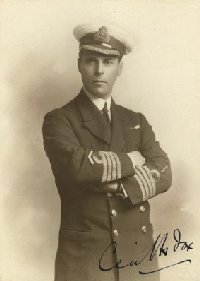
Born 27th May 1873. Died 1963. Captain Cecil H. Fox commanded H.M.S.
Amphion in the first naval conflict of the first world war just hours after the declaration, and which itself became the first British casualty a day later. Later commanded HMS
Undaunted in successful action against German mine layers in the Thames Estuary 17th October 1914. Fox collaborated on a radio programme in April 1951 broadcast by the BBC (British Broadcasting Corporation), and penned an article for the
Radio Times reproduced here. In 1904 as a Lieutenant on HMS
Impregnable, he re-wrote the Manual of Seamanship for Boys' and Seamen of the Royal Navy. Promoted Rear Admiral 2nd May 1922.
So far, he died as the last surviving member of the ship's crew that I have been able to locate.
Details from Royal Navy Officer's service record, National Archives at Kew.
Chief Petty officer, Captain of the Main Top, Thomas Gibbs
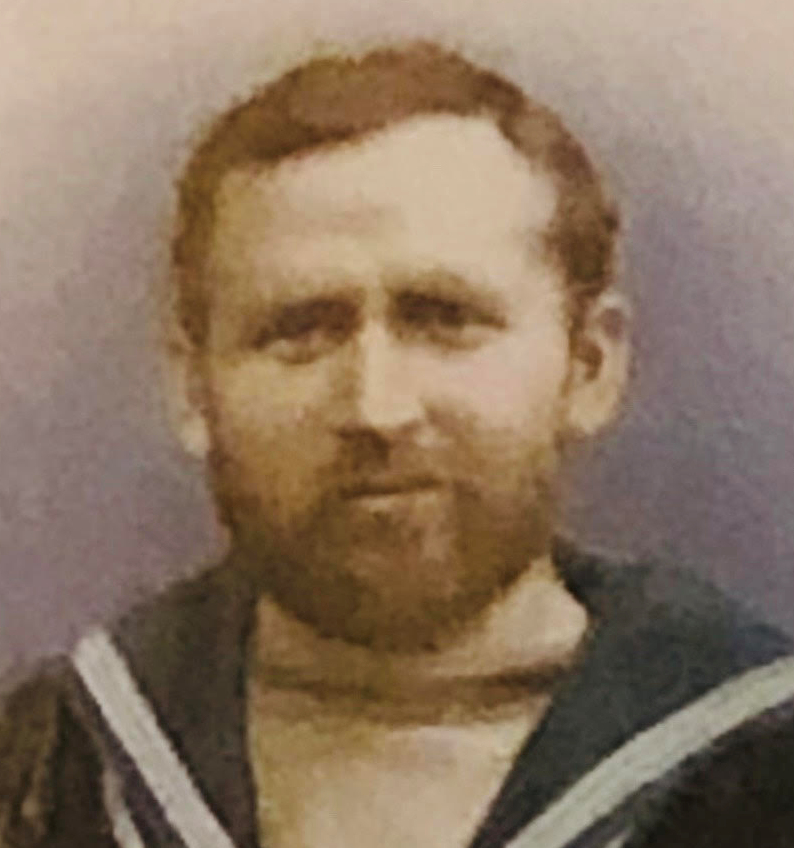
The image is part of a photograph of Thomas showing him with rank insignia of a Gunner's Mate or similar, and with the 5 years Long Service and Good Conduct stripe or chevron. At Samoa, Thomas held the rank of Chief Petty Officer.
Details and image courtesy of Dominic Mason.
Midshipman (later Vice-Admiral) John Collings Taswell Glossop C.B.
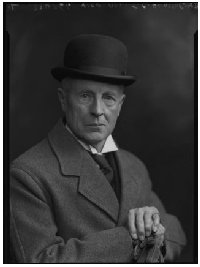
Born 23rd October, 1871. Died: 23rd December, 1934. Captain J. C. T. Glossop commanded the Chatham Class Light Cruiser H.M.A.S.
Sydney in her epic first world war battle with the German cruiser Emden off the Cocos Islands in November 1914. Intriguingly (as will be seen by the reference to Midshipman Hood later in this list), Glossop had earlier commanded (as Captain) between September 1910 and April 1911, the third Royal Navy ship to be named "
Hood" (launched July 1891, sunk as a blockade hulk in the Portland Harbour breakwater in late 1914). A memorial in Holy Trinity Old Church, Bothenhampton, Dorset, England reads: '
Retired Officer de Legion d'Honneur. Churchwarden of his parish 1922-34'.
Details from Royal Navy Officer's service record, National Archives at Kew.
Ordinary Seaman William Harding
He was born in Handley, Hampshire in 1868 and enlisted in the RN as a Boy Seaman in 1885, Service Number 133768. He served in Calliope as an Ordinary Seaman, his first sea-going appointment. At the end of her commission in 1890 he went on to serve in Wallaroo (1891), Rapid, a composite screw corvette (1891 to 1895) and Australia (1895-96). In 1896 he transfered to HM Coastguard and served in different stations on the south coast of England, eg Ventnor, Stokes Bay and Fishbourne. He was mobilised in 1914 and served at sea in the armed boarding steamer Stephen Furness, patrolling the northern Irish coast (1915-16) and the armed merchant cruiser Kildonan Castle, deployed in the Northern Patrol on the blockade of Germany (1916 - 1918). He was demobilised in February 1919 with the rank of Petty Officer 1st Class. He was awarded the 1914-15 Star, British War Medal, Victory Medal and RN Long Service and Good Conduct Medal. He also had the unofficial medal produced and presented by the Marquis of Leuville for the officers and crew of HMS Calliope. [Scaramouche note: a Henry B Harding was a stoker on Calliope, and may well have been a relative of William's.]
Details courtesy of Chris Bilham.
Midshipman (later Rear Admiral) the Honorable Horace Lambert Alexander Hood K.C.B., M.V.O., D.S.O.
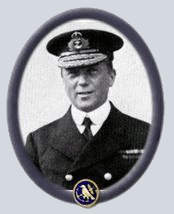
Born October 2nd, 1870, died May 31st, 1916. The name "Hood" has been evocative with the Royal Navy for many years. Admiral, Sir Samuel Hood 1st Viscount Hood Of Whitley was Hood's great, great grandfather and served with Nelson. H.L.A. Hood joined the Navy in 1883 : H.M.S.
Temeraire, H.M.S.
Hyacinth; 1887 : H.M.S.
Calliope. During the first World War as Rear-Admiral on H.M.S.
Invincible, he perished with all but 6 of her complement of more than 1,000 at the Battle of Jutland May 31st, 1916, his flagship being the fourth British battle cruiser to be lost on that day due to poor storage and handling of the cordite charges in the magazines. His family name (or more precisely, that of Lord Samuel Hood) was used for the ship - the 4th of 5 to utilise that name - launched 2 years later by his widow which would meet its own similar fate from the
Bismarck on May 24th, 25 years after. He was the 4th child (3rd son) of 4th Viscount Hood (Francis Wheler Hood) and Viscountess Hood, (Edith Lydia Drummond Ward, daughter of Arthur Ward Esq.); he was the husband of the Hon. Lady Hood (Ellen Touzalin, the widow of George Nickerson), of East Sheen Lodge, Sheen, Surrey. His memorial is on the Portsmouth Naval Memorial, Hampshire.
At the recent 100th commemoration of the Battle of Jutland, May 31st, 2016, the bell from the fourth HMS Calliope was rung during the service at Scapa Flow, and the presenters discussed the ship in a little detail. Sadly, no mention was made that Rear-Admiral Hood had been a midshipman on the previous Calliope.
Details from Royal Navy Officer's service record, National Archives at Kew.
Midshipman (later Captain) Hugh Fitzroy Hopkinson
Born 11th October, 1871. Died 5th June 1922. In 1894, Hugh Hopkinson was Lieutenant on H.M.S. Pygmy. Granted Portuguese Military Order of Avis (1918) and Portuguese Order of Christ (1919) for services rendered in transporting the Portuguese Army from Lisbon to Brest during 1917.
Details from Royal Navy Officer's service record, National Archives at Kew.
Carpenters Mate Thomas D. John
Severely injured during the storm, suffering a fractured skull. On Calliope's return to Sydney, was transferred to St. Vincent's Hospital, Sydney where after some months of treatment, he was able to take passage back to England and eventually invalided out of the service.
Captain (later Admiral) H. C. Kane, K.C.B
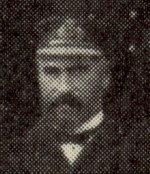
Henry Coey Kane was born in December 1843, I am not certain of the precise date, but see the final paragraph below. His father was the celebrated Irish Research chemist, Sir Robert Kane, who was the only Catholic member of the "Irish Relief Commissioners" board tasked to investigate the causes and possible solutions to the Irish Potato Blight in the 1850s. Sir Robert was the author of the influential book "The Industrial Resources of Ireland" for which he received much acclaim when it was published in 1843. Kane's mother, Katharine (nee Bailey), was a noted botanist and author in her own right; "Irish Fauna" was one her titles.
The family appear to have lived in Gloucester Street, Dublin during the early part of the nineteenth century. Kane had no less than eight siblings, some of whom achieved prominence in their own right, but little about the lives and fortunes of the various family members is available on-line - or at least, that I have managed to locate. Robert Romney Kane (1842 - 1902) was a renowned writer on Irish land law, and seems to have been a brother.
Henry Kane was fluent in French and Italian, and fair in German and Spanish. He received excellent comment from his superiors throughout his naval career, which included reports on the fortifications of Cadiz in December 1871 and Carthagena in 1874. In 1882, he was promoted Captain and commanded HMS Northumberland. In 1883 he was made a Naval Attache, and was wounded in the battles of Tel-El-Kebir for which he received much credit. Their Lordships regularly expressed their great satisfaction at this zealous and able officer.
Soon after
Calliope's return to England after the commissioning voyage, he was appointed to command H.M.S.
Inflexible. On March 20th, 1892 Kane was appointed Captain of HMS
Victory at Portsmouth, a post he retained until April 19th, 1894. Kane was made Admiral in 1907. He was made Knight Commander of the Bath in 1911. Admiral Kane does not seem to have ever married and died January 30th, 1917.
Details from Officer's Service Record, Internet, and various other sources.
A 2017 visitor to the site has kindly provided some additional details for Captain Kane. He was born in Dublin, possibly Booterstown, on December 15th, 1843 and baptized in Booterstown Roman Catholic Church on the 21st. He attended
St. Vincent's College in Castleknock, County Dublin, which was also the school for my correspondent, who remembers a painting of Captain Kane in the Refectory. He is buried at the
St. Thomas of Canterbury Roman Catholic Church in Fulham.
Details Courtesy of Peter Power-Hynes.
I have recently been in contact with Castleknock's St. Vincent's College, who have most kindly sent me a great deal of information about their illustrious "pastman", such that I have decided to create a page (still under construction) on the web-site dedicated to him. I cannot acknowledge too much their kindness in supplying the data.
Leading Stoker Mark King
Born 22nd November 1861. Hayling Island, Hampshire. His previous occupation seems to have been as a Groom. Joined the Navy on 2nd October 1882 as a Stoker 2nd. Class. Discharged dead on 3rd June 1910.
Some very comprehensive details of this man's service life can be found at
this web site.
Details from Royal Navy Officer's service record, National Archives at Kew.
Cooper David Francis Mahoney
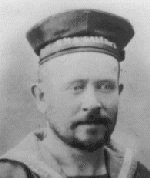
Born 1855 in Cork City, Ireland. Died: 1st November, 1939 Cardiff, South Wales. Married Annie Swanton of Cork, was living in Kent when a member of
Calliope's crew at Apia, after retirement he worked at Gravesend Dockyard. On the death of his wife, he moved his three children Frances, Kathleen and Robert to Cardiff. Appears to have been identified in some sources as "David O'Mahoney".
David and Michael Finnie both hailed from Cork in Ireland.
Details courtesy of Marian Scanlan.
Lieutenant R.M.L.I. Alfred E. Marchant
Lieutenant Alfred Edmund Marchant, Royal Marine Light Infantry commanding Calliope's marines, distinguished himself during the Boer War when as Captain he took command of the Naval Brigade whilst under intense enemy fire during the famous battle at Graspan Heights (1900), following which he was promoted Major. He was appointed one of two Marine Aides-de-Camp to His Majesty, King George V on 12th October, 1910.
Obituary: We regret to announce that Major-General Marchant, CBRMLI (retired) died of pneumonia at Ospedaleti, Ligure, Italy on Jan. 21st at the age of sixty-nine [Scaramouche: actually aged 60]. The son [Scaramouche: possibly stepson] of Mr William Lavington Marchant of Adelaide, South Australia, where he was born on Feb. 26th 1863, he entered the Royal Marines as a probationary lieutenant in September 1881, and was posted to the RMLI. He was promoted to Captain in August 1890, Major in Nov.1899, brevet Lt. Col. in Dec 1907, brevet Colonel June 1910, and Colonel and Commandant in Jan.1911. In the Great War he served with the R M Brigade during the defence of Antwerp in October 1914. In April 1915, he was appointed to command the Chatham Division RMLI with the temporary rank of Brigadier-General and held the appointment until April 1918. In the following August he was placed on the retired list with the honorary rank of Major-General. General Marchant served with the Royal Marine Battalion at Suakin from July 1884 to April 1885 and was present at the actions of Hasheen and Tofrek, and was wounded in the attack on McNeills zariba, receiving the Egyptian Medal with two clasps and the Khedive Bronze Star. As a lieutenant he commanded the Royal Marine detachment of HMS Calliope and was serving in her when she made her wonderful escape from the hurricane in the harbour of Apia, Somoa, under the command of Captain H C Kane, RN. In the South African War {Anglo-Boer War}, he served throughout with the Naval Brigade. After the action of Graspan he brought the Naval Brigade out of action and was promoted to Major. He was present at the actions of Belmont, Modder River, Magersfontein, Paardeberg, Osfontein, the capture of Bloemfontein, the entry into Pretoria, and the actions at Diamond Hill and Bergendal, being three times mentioned in despatches and awarded the CB and the Queen's Medal with seven clasps. From 1904 to 1906 he served again in Australia and was ADC to the King from 1910 to 1918. General Marchant married in 1890 Mary C Homersham, and secondly in 1897 Edith Mary Turner, who survives him with two daughters.
Details from London Times Weekly, 31 January, 1924.
Boatswain William Marshfield
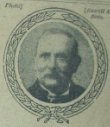
In 1893, Marshfield was the Boatswain on H.M.S.
Victoria, flagship of Admiral Sir George Tryon, of the Mediterranean Fleet, when the Admiral inexplicably ordered his ship and HMS
Camperdown to turn towards each other with no possibility of escaping a collision, which event sunk
Victoria and drowned 350 men. Marshfield continued the good luck he had on
Calliope and survived this disaster too.
Details from the Penny Pictorial article courtesy of Marian Scanlan.
Lieutenant (Later Rear-Admiral) Robert Kyle McAlpine
Born 20th January 1851. Died 22nd September 1923. Name also sometimes spelt MacAlpine.
This gentleman joined the navy on 1st October 1864 aged 13 years as a cadet on HMS Britannia. Appointed Midshipman 19th December 1866, Acting Sub-Lieutenant on 18th June 1871 (HMS Inconstant), and Sub-Lieutenant on 18th September the same year (HMS Duke of Wellington). His promotion to Lieutenant came on the 15th October 1875 (first served at that rank HMS Repulse), to Commander on 30th June 1889 (HMS Calliope), Captain 31st December 1896 (HMS Narcissus), and Rear Admiral on 17th November 1906. Throughout his naval career, he received exemplary reports from his superior officers and many recommendations for advancement in the service.
Details from Royal Navy Officer's service record, National Archives at Kew.
Able Seaman (General Service) William Miller
This gentleman was one of the sailors portrayed in the Radio Times play about the hurricane. So I guess he played an important part in Calliope's escape. (See also James Baldry.) William was played by a Harry Carter.
See the Radio Times, "Programme Listing" and the Samoan Adventure.
Lieutenant Henry G. Monckton
In 1894, Monckton was the Lieutenant commanding H.M.S. Sunflower, a sailing ship.
Leading Seaman James Cresswell Moore

James Cresswell Moore was born in September 1865 at Basford, Nottingham, and joined his first ship, HMS
Northumberland as a Boy on Jan 1st 1883. He subsequently served on the
Invincible,
Duke of Wellington,
Alexandra,
Dart,
Pembroke,
Wildfire,
Howe and of course
Calliope for two years Jan '87 to Oct '89. His son (who provided these details) remembers him saying that he was one of the men assigned to the wheel to help steer
Calliope out of the bay. After an honourable discharge from the Navy he joined the Sherwood Foresters as a Sapper and saw service in India and France during the 1st World War. He married in 1902 and died in 1948 aged 84 years. Click the image for a larger picture of a number of the crew.
Details courtesy of Arthur Moore.
Skilled Carpenter's Mate Julius W. Newberry
(Also recorded as Newbury). May at some time have served on HMS Superb as 'Shipwright'. Born Guernsey. Commissioned around 1890, he retired from the Navy around 1913 but was recalled for War service and died in 1918.
Details courtesy of "Nigel".
Midshipman (Later Admiral) Wilmot Stuart Nicholson C.B.
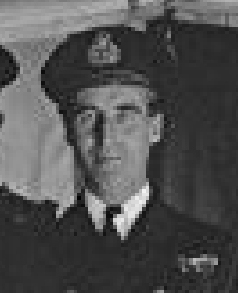
Born 18th May 1872. Died 9th June 1947. Nicholson was Captain of HMS
Hogue when that cruiser, along with
Cressy and
Aboukir, were sunk by submarine U9 on 22nd September, 1914. Captain of HMS
Aurora at Jutland, May 1916.
The image shows Admiral Nicholson c.1936.
Details from Royal Navy Officer's service record, National Archives at Kew.
Carpenter Michael O'Brien
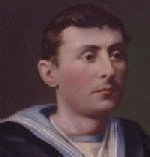
Michael William O'Brien was born on October 6th 1861 in Jersey, Channel Islands. He was the son of Michael O'Brian and Mary Ann O'Moore. His father passed away while Michael was still young and he grew up in Jersey with his mother and elder sister. On October 6th 1879, at the age of eighteen, Michael signed up as a rating in the Royal Navy for a ten year period. He is described as being 5'3" brown hair, brown eyes and a fair complexion. A second entry, which is not dated, modifies his height as 5'6" with the trade of carpenter and the addition of a tattoo on his left arm reading "sailor" and "true love". Michael left the navy on the 15th April 1890, HMS
Calliope was his last ship. He moved to Bristol where in 1891 he is recorded as the landlord of the Bird in Hand pub. Living with him was his mother Mary Ann and his brother-in-law James Giles.
Details courtesy of Andrew Price.
Lieutenant (later Captain) Henry Pearson
Born c. 1852, Died: 17th August, 1936. A memorial in Winchester Cathedral, Hampshire reads: 'In memory of Henry Pearson Captain RN of this city who died 17 August 1936 aged 84. He was navigating officer when HMS Calliope (Capt H C Kane) was brought out of Apia Harbour in Samoa in the hurricane of 16th March 1889.'
Able Seaman Joseph Potter
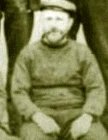
Came from Dover and was born 13th April 1864. After his Naval service he served in the Coastguard at Sheerness and sadly died in 1911 aged only 47 years.
Details courtesy of Eddie Savage.
Midshipman (later Commander) Edmund James Prendergast O.B.E.
Born 10th February 1872, Died: 25th January, 1936. Awarded O.B.E. for services in Wireless Telegraphy during 1st World War.
Details from Royal Navy Officer's service record, National Archives at Kew.
Able Seaman (General Service) Frederick Rex
b. Dec 2, 1867 d. Feb 27, 1934. Born at Portsea Island, Hants. His father and grandfather were both Stonemasons. It was said that he ran away to sea at the age of thirteen. He joined the navy, presumably at eighteen. Although he appears in the Calliope crew list as an Able Seaman, to family knowledge he was, or became, a Signalman. He married Anne Marie Wood from Chartham in Kent (circa 1895). He left the navy probably in 1897. At that time he joined the Coastguard Service and was stationed at Rye Harbour. In about 1910 he left the coastguard service and retired with his family to his wife's home village of Chartham near Canterbury where he died and was buried in 1934.
Details courtesy of Ivan Harrison.
Chief ERA James Richards
On Sunday, February 3rd 1889, the day after Calliope's arrival at Apia, Kane discharged forty-two year old Chief ERA (Engine Room Artificer) James Richards accompanied by an AB seaman and a blacksmith to HMS Royalist for transport back to Sydney. Richards had been taken ill shortly after the ship left New Zealand and his condition had been deteriorating steadily in Calliope's sick bay. Unfortunately, he died a few days after Royalist departed Tonga for the run to Auckland and later in the evening of that same Wedenesday 13th February, his body was committed to the deep, unknown to the Calliopes, her first death of the voyage.
James Friend Richards was born on 24th January 1847 in the East Stonehouse district of Plymouth in Devon. He was the eldest son of a professional Royal Navy sailor who had travelled the world. He married Elizabeth Marks on 19th July 1868 and joined the Royal Navy on 12th April 1871, when he was described as being 5'11 in height, with black hair, black eyes and dark complexion and being a fitter by trade. He died on 14th February 1889 at 4 a.m. from hepatitis and an abscess of the liver. By the time of his death, he had accrued three Good Conduct badges and had therefore been awarded the Royal Navy Long Service and Good Conduct Medal.
Details from HMS Calliope and HMS Royalist Ship's Logs, National Archives at Kew, and a descendant Nathan Richards.
Assistant Engineer (later Captain?) James Robert Roffey
He was born in 1862 in Woolwich Kent, the second of seven children. He was the eldest of the two sons of James Roffey (later Sir James Roffey of Havant, Hampshire) and his wife Emma Roffey. Sir James was also in the Royal Navy and became Chief Inspector of Machinery. James Robert married Fanny Munro Petman in 1897 and they had at least one child, a son called Bernard Wilson Roffey, possibly there were others. James Robert Roffey died on 17th July 1914 aged 51 and his gravestone reads "Captain James Robert Roffey RN". He is buried in in Havant Cemetery in an adjacent plot to his parents Sir James Roffey (died 1.5.1912 aged 79) and Dame Emma Roffey (died 28.12.1914 aged 76) and his wife Fanny Munro Roffey (died 15.10.1936 aged 71).
Details courtesy of Sue Lynch.
I have been contacted by a descendant of this gentleman who lives in the United States to see if they could contact Sue Lynch. My contact was many years ago, and I have lost Sue's e-mail adress, so if anyone has information about Sue, or indeed this gentleman, please us my
contact form to let me know and perhaps I could put you both in touch.
Coxswain second class William Rolfe
Died in St. Vincent's Hospital at Sydney on June 10th, 1889 following an accidental fall at Larg's Bay a few days earlier.
Ordinary Seaman James Spiller
James Spiller was born in Sedbury, Devon on the 5th November 1870 and joined the Navy on the 1st November 1886 as a Boy 2 class. After 20 Months on the training ship
Boscawen he joined HMS
Orlando and on the 5th November 1888 having engaged to serve for 12 years he was rated as an Ordinary Seaman. Spiller served on
Orlando from 5th June 1888 to 28th July 1891 except for the period between 20th January 1889 to 12th September 1889 when he served on HMS
Calliope. Spiller was rated as an Able Seaman on 1st May 1891 and on leaving
Orlando he served mainly aboard the Battleships:
Alexandra, Resolution, Revenge and
Hibernia until in May 1900 when he joined the Coast Guard Service being awarded the LSGC Medal in 1910.
At the outbreak of the first World War he was a Leading Boatman in the Coast Guard but on the 1st August 1914 he returned to the Navy as an Able Seaman and died on 1st November 1914 when H.M.S.
Monmouth was sunk at the
Battle of Coronel serving under
Captain Frank Brandt (also on this page).
Details courtesy of Derek Riley.
Leading Seaman William Isaac Thorndale
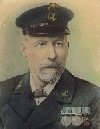
b. July 17, 1861 : d. August 30, 1949. Born Reigate, Surrey. Joined the navy at age 15. Served in HMS
Sultan during the bombardment of Alexandria in 1882. Left
Calliope at the end of the commissioning voyage to join the Coastguard service at Ballycroneen, (now) Southern Ireland. In 1884, he married Jane Dowling, daughter of Anne Dowling. Had two daughters, Winifred Sarah (1893) and Evelyn Baverstock (1895). Continued coastguard service at Studland in Dorset 1910 and retired to Reigate in 1919, his service extended by the war years. Naval Service : 1876 : H.M.S.
Fisguard, H. M. S.
Implacable; 1877 : H.M.S.
Trudeyant[?], H.M.S.
Liberty; 1878 : H.M.S.
Lion (these were all training ships); 1878 : H.M.S.
Iron Duke; 1879: H.M.S.
Lapwing, H.M.S.
Charybdis; 1881 : H.M.S.
Duncan; 1882 : H.M.S.
Duke of Wellington; 1884: H.M.S.
Sultan; 1885 : H.M.S.
Excellent, HMS
Minotaur; 1887 : H.M.S.
Calliope; 1890 : HMS
Excellent for paying off.
Service details extracted from Thorndale's hand-written memoirs and Seaman's Service Record at the National Archives at Kew. Query marks [?] indicate uncertain spelling.

 Born 24 October 1844 in Devonport, the only child of Michael Bourke, an Irish seaman,(rising to quartermaster) and his wife Mary Ann Odgers of Plymouth. He married Amelia Campbell, daughter of an Irish coastguard who had several postings in England. Fleet Engineer Bourke's Career details are: Asst. Eng. 1st Class 27 Oct 1867. 19 Sep 1869 TAMAR, troopship 2812 tons various ("particular" service). Engineer 19 Jul 1871. 30 Oct 1872 MOSQUITO gunboat 408 tons China. 15 Sep 1876 WARRIOR-Reserve-coastguard ship Portland. 14 Sep 1878 URGENT-depotship for gunboat service Jamaica. 2 Mar 1882 SULTAN battleship 9290 tons Channel Sqn. Chief Engineer 16 Oct 1883. 29 Nov 1883 OSPREY sloop East Indies. 16 Aug 1886 CALLIOPE corvette 2770 tons Portsmouth. Staff Engineer 16 Oct 1887 Still on Calliope Australia. Fleet Engineer 28 May 1889 accelerated promotion after storm. (Dec 1889) Calliope still returning home. 26 Nov 1890 HERO battleship-tender to Portsmouth EXCELLENT. 2 Dec 1893 HERCULES battleship (Reserve) Portsmouth. 1 Jan 1896 VICTORY Portsmouth. 5 Mar 1898 Died in RNH Haslar of pneumonia.
Born 24 October 1844 in Devonport, the only child of Michael Bourke, an Irish seaman,(rising to quartermaster) and his wife Mary Ann Odgers of Plymouth. He married Amelia Campbell, daughter of an Irish coastguard who had several postings in England. Fleet Engineer Bourke's Career details are: Asst. Eng. 1st Class 27 Oct 1867. 19 Sep 1869 TAMAR, troopship 2812 tons various ("particular" service). Engineer 19 Jul 1871. 30 Oct 1872 MOSQUITO gunboat 408 tons China. 15 Sep 1876 WARRIOR-Reserve-coastguard ship Portland. 14 Sep 1878 URGENT-depotship for gunboat service Jamaica. 2 Mar 1882 SULTAN battleship 9290 tons Channel Sqn. Chief Engineer 16 Oct 1883. 29 Nov 1883 OSPREY sloop East Indies. 16 Aug 1886 CALLIOPE corvette 2770 tons Portsmouth. Staff Engineer 16 Oct 1887 Still on Calliope Australia. Fleet Engineer 28 May 1889 accelerated promotion after storm. (Dec 1889) Calliope still returning home. 26 Nov 1890 HERO battleship-tender to Portsmouth EXCELLENT. 2 Dec 1893 HERCULES battleship (Reserve) Portsmouth. 1 Jan 1896 VICTORY Portsmouth. 5 Mar 1898 Died in RNH Haslar of pneumonia.
 Born October 2nd, 1871. Died: November 1st, 1914. Captain Frank Brandt commanded H.M.S. Monmouth in the battle of Coronel off the coast of Chile and perished in the ship which was lost with all hands. Brandt seems to have been born in Cheltenham, though his widow (Beryl) was quoted as living in Worthing. His parents were Francis Brandt, I.C.S. (Judge in the High Court, Madras), and Lucy Sophia (nee Dobson). His name is recorded on the Plymouth Naval Memorial, Devon. He and his sister Ethel spent much of their early years with an Aunt, Miss Emily Charlotte Brandt at her home Saint Roque in Torquay. Frank's grandson was the late Admiral Sir Hugo White.
Born October 2nd, 1871. Died: November 1st, 1914. Captain Frank Brandt commanded H.M.S. Monmouth in the battle of Coronel off the coast of Chile and perished in the ship which was lost with all hands. Brandt seems to have been born in Cheltenham, though his widow (Beryl) was quoted as living in Worthing. His parents were Francis Brandt, I.C.S. (Judge in the High Court, Madras), and Lucy Sophia (nee Dobson). His name is recorded on the Plymouth Naval Memorial, Devon. He and his sister Ethel spent much of their early years with an Aunt, Miss Emily Charlotte Brandt at her home Saint Roque in Torquay. Frank's grandson was the late Admiral Sir Hugo White.
 ARTHUR WILLIAM CARTER 1856-1931 was a son of Rev. Thomas Garden Carter, Vicar at Linton in Kent, and his wife Louisa (Turner). An extract from "The Linton Estate: the property of Messrs Carter Bros." in The Pastoral Review, Sydney, c. 1909 reads: [He] joined the Navy on the 15th January 1870, was promoted sub-Lieutenant on 20th June 1875, Lieutenant 13th December 1879, Commander 1st January 1894, Captain 30th June 1899, retiring with the rank of Captain on 28th January 1905. He was appointed Rear-Admiral on the retired list on 5th November 1908. He served with the Naval Brigade in the Soudan [along with many future Calliope shipmates including Captain Kane and WIT - Scaramouche], with the Nile Expedition for the relief of General Gordon 1884-5, and received the Egyptian medal with Nile clasp and Khedive's Grand Star. He was Lieutenant on the "Calliope" on the occasion of the great hurricane at Apia in 1889, when that vessel, by a splendid piece of seamanship on the part of her crew, escaped the fate of most of the other warships then in the harbour. The Admiralty expressed admiration at the officers' behaviour on that occasion, and specially referred to Lieutenant Carter. He retired from the Navy in order that he might assist his brother in the management of their joint property [in northern New South Wales].
ARTHUR WILLIAM CARTER 1856-1931 was a son of Rev. Thomas Garden Carter, Vicar at Linton in Kent, and his wife Louisa (Turner). An extract from "The Linton Estate: the property of Messrs Carter Bros." in The Pastoral Review, Sydney, c. 1909 reads: [He] joined the Navy on the 15th January 1870, was promoted sub-Lieutenant on 20th June 1875, Lieutenant 13th December 1879, Commander 1st January 1894, Captain 30th June 1899, retiring with the rank of Captain on 28th January 1905. He was appointed Rear-Admiral on the retired list on 5th November 1908. He served with the Naval Brigade in the Soudan [along with many future Calliope shipmates including Captain Kane and WIT - Scaramouche], with the Nile Expedition for the relief of General Gordon 1884-5, and received the Egyptian medal with Nile clasp and Khedive's Grand Star. He was Lieutenant on the "Calliope" on the occasion of the great hurricane at Apia in 1889, when that vessel, by a splendid piece of seamanship on the part of her crew, escaped the fate of most of the other warships then in the harbour. The Admiralty expressed admiration at the officers' behaviour on that occasion, and specially referred to Lieutenant Carter. He retired from the Navy in order that he might assist his brother in the management of their joint property [in northern New South Wales]. Ernest was born in Selsey, Chichester, Sussex. He seems to have joined the navy for 12 years on his 18th birthday, 18th April, 1889, but that is usually the date of his actual service, most people having joined earlier as a boy, possibly in his case on 2nd February 1886. He initially served on HMS Impregnable, followed by a long list of ships: Ganges, Impregnable again, Thalis, Nelson, Calliope, Duke of Wellington, Volage, Excellent, Vernon, Excellent again, Victory I, Trafalgar, Victory I again, Inflexible, Victory I again, Edinburgh, Excellent again, Edinburgh again, Vernon again, Edinburgh again, Rodney, Victory I again, Terrible, Vernon again, Tamar, Albion, Tamar again, Firequeen II, Barfleur, Naiobe, Empress of India, Victory I again, Vernon again, Victory I again, Pandora, Victory I again, Victory II, Volage(?) again, and was pensioned off from HMS Victory I which he left in April 1911. It is most likely that those ships which he joined from a vessel such as HMS Edinburgh to HMS Vernon and back to HMS Edinburgh, were temporary detachments to training ships attached to the former.
Ernest was born in Selsey, Chichester, Sussex. He seems to have joined the navy for 12 years on his 18th birthday, 18th April, 1889, but that is usually the date of his actual service, most people having joined earlier as a boy, possibly in his case on 2nd February 1886. He initially served on HMS Impregnable, followed by a long list of ships: Ganges, Impregnable again, Thalis, Nelson, Calliope, Duke of Wellington, Volage, Excellent, Vernon, Excellent again, Victory I, Trafalgar, Victory I again, Inflexible, Victory I again, Edinburgh, Excellent again, Edinburgh again, Vernon again, Edinburgh again, Rodney, Victory I again, Terrible, Vernon again, Tamar, Albion, Tamar again, Firequeen II, Barfleur, Naiobe, Empress of India, Victory I again, Vernon again, Victory I again, Pandora, Victory I again, Victory II, Volage(?) again, and was pensioned off from HMS Victory I which he left in April 1911. It is most likely that those ships which he joined from a vessel such as HMS Edinburgh to HMS Vernon and back to HMS Edinburgh, were temporary detachments to training ships attached to the former.
 Born 19th October, 1871. Died January 1945. Was Captain of HMS Chatham when she discovered and shelled the German raider Koenigsberg about six miles up the Rufigi River Delta, opposite Mafia Island (German East Africa) in October 1914.
Born 19th October, 1871. Died January 1945. Was Captain of HMS Chatham when she discovered and shelled the German raider Koenigsberg about six miles up the Rufigi River Delta, opposite Mafia Island (German East Africa) in October 1914.
 Born 27th May 1873. Died 1963. Captain Cecil H. Fox commanded H.M.S. Amphion in the first naval conflict of the first world war just hours after the declaration, and which itself became the first British casualty a day later. Later commanded HMS Undaunted in successful action against German mine layers in the Thames Estuary 17th October 1914. Fox collaborated on a radio programme in April 1951 broadcast by the BBC (British Broadcasting Corporation), and penned an article for the Radio Times reproduced here. In 1904 as a Lieutenant on HMS Impregnable, he re-wrote the Manual of Seamanship for Boys' and Seamen of the Royal Navy. Promoted Rear Admiral 2nd May 1922.
Born 27th May 1873. Died 1963. Captain Cecil H. Fox commanded H.M.S. Amphion in the first naval conflict of the first world war just hours after the declaration, and which itself became the first British casualty a day later. Later commanded HMS Undaunted in successful action against German mine layers in the Thames Estuary 17th October 1914. Fox collaborated on a radio programme in April 1951 broadcast by the BBC (British Broadcasting Corporation), and penned an article for the Radio Times reproduced here. In 1904 as a Lieutenant on HMS Impregnable, he re-wrote the Manual of Seamanship for Boys' and Seamen of the Royal Navy. Promoted Rear Admiral 2nd May 1922.
 The image is part of a photograph of Thomas showing him with rank insignia of a Gunner's Mate or similar, and with the 5 years Long Service and Good Conduct stripe or chevron. At Samoa, Thomas held the rank of Chief Petty Officer.
The image is part of a photograph of Thomas showing him with rank insignia of a Gunner's Mate or similar, and with the 5 years Long Service and Good Conduct stripe or chevron. At Samoa, Thomas held the rank of Chief Petty Officer.
 Born 23rd October, 1871. Died: 23rd December, 1934. Captain J. C. T. Glossop commanded the Chatham Class Light Cruiser H.M.A.S. Sydney in her epic first world war battle with the German cruiser Emden off the Cocos Islands in November 1914. Intriguingly (as will be seen by the reference to Midshipman Hood later in this list), Glossop had earlier commanded (as Captain) between September 1910 and April 1911, the third Royal Navy ship to be named "Hood" (launched July 1891, sunk as a blockade hulk in the Portland Harbour breakwater in late 1914). A memorial in Holy Trinity Old Church, Bothenhampton, Dorset, England reads: 'Retired Officer de Legion d'Honneur. Churchwarden of his parish 1922-34'.
Born 23rd October, 1871. Died: 23rd December, 1934. Captain J. C. T. Glossop commanded the Chatham Class Light Cruiser H.M.A.S. Sydney in her epic first world war battle with the German cruiser Emden off the Cocos Islands in November 1914. Intriguingly (as will be seen by the reference to Midshipman Hood later in this list), Glossop had earlier commanded (as Captain) between September 1910 and April 1911, the third Royal Navy ship to be named "Hood" (launched July 1891, sunk as a blockade hulk in the Portland Harbour breakwater in late 1914). A memorial in Holy Trinity Old Church, Bothenhampton, Dorset, England reads: 'Retired Officer de Legion d'Honneur. Churchwarden of his parish 1922-34'.
 Born October 2nd, 1870, died May 31st, 1916. The name "Hood" has been evocative with the Royal Navy for many years. Admiral, Sir Samuel Hood 1st Viscount Hood Of Whitley was Hood's great, great grandfather and served with Nelson. H.L.A. Hood joined the Navy in 1883 : H.M.S. Temeraire, H.M.S. Hyacinth; 1887 : H.M.S. Calliope. During the first World War as Rear-Admiral on H.M.S. Invincible, he perished with all but 6 of her complement of more than 1,000 at the Battle of Jutland May 31st, 1916, his flagship being the fourth British battle cruiser to be lost on that day due to poor storage and handling of the cordite charges in the magazines. His family name (or more precisely, that of Lord Samuel Hood) was used for the ship - the 4th of 5 to utilise that name - launched 2 years later by his widow which would meet its own similar fate from the Bismarck on May 24th, 25 years after. He was the 4th child (3rd son) of 4th Viscount Hood (Francis Wheler Hood) and Viscountess Hood, (Edith Lydia Drummond Ward, daughter of Arthur Ward Esq.); he was the husband of the Hon. Lady Hood (Ellen Touzalin, the widow of George Nickerson), of East Sheen Lodge, Sheen, Surrey. His memorial is on the Portsmouth Naval Memorial, Hampshire.
Born October 2nd, 1870, died May 31st, 1916. The name "Hood" has been evocative with the Royal Navy for many years. Admiral, Sir Samuel Hood 1st Viscount Hood Of Whitley was Hood's great, great grandfather and served with Nelson. H.L.A. Hood joined the Navy in 1883 : H.M.S. Temeraire, H.M.S. Hyacinth; 1887 : H.M.S. Calliope. During the first World War as Rear-Admiral on H.M.S. Invincible, he perished with all but 6 of her complement of more than 1,000 at the Battle of Jutland May 31st, 1916, his flagship being the fourth British battle cruiser to be lost on that day due to poor storage and handling of the cordite charges in the magazines. His family name (or more precisely, that of Lord Samuel Hood) was used for the ship - the 4th of 5 to utilise that name - launched 2 years later by his widow which would meet its own similar fate from the Bismarck on May 24th, 25 years after. He was the 4th child (3rd son) of 4th Viscount Hood (Francis Wheler Hood) and Viscountess Hood, (Edith Lydia Drummond Ward, daughter of Arthur Ward Esq.); he was the husband of the Hon. Lady Hood (Ellen Touzalin, the widow of George Nickerson), of East Sheen Lodge, Sheen, Surrey. His memorial is on the Portsmouth Naval Memorial, Hampshire.
 Henry Coey Kane was born in December 1843, I am not certain of the precise date, but see the final paragraph below. His father was the celebrated Irish Research chemist, Sir Robert Kane, who was the only Catholic member of the "Irish Relief Commissioners" board tasked to investigate the causes and possible solutions to the Irish Potato Blight in the 1850s. Sir Robert was the author of the influential book "The Industrial Resources of Ireland" for which he received much acclaim when it was published in 1843. Kane's mother, Katharine (nee Bailey), was a noted botanist and author in her own right; "Irish Fauna" was one her titles.
Henry Coey Kane was born in December 1843, I am not certain of the precise date, but see the final paragraph below. His father was the celebrated Irish Research chemist, Sir Robert Kane, who was the only Catholic member of the "Irish Relief Commissioners" board tasked to investigate the causes and possible solutions to the Irish Potato Blight in the 1850s. Sir Robert was the author of the influential book "The Industrial Resources of Ireland" for which he received much acclaim when it was published in 1843. Kane's mother, Katharine (nee Bailey), was a noted botanist and author in her own right; "Irish Fauna" was one her titles. Born 1855 in Cork City, Ireland. Died: 1st November, 1939 Cardiff, South Wales. Married Annie Swanton of Cork, was living in Kent when a member of Calliope's crew at Apia, after retirement he worked at Gravesend Dockyard. On the death of his wife, he moved his three children Frances, Kathleen and Robert to Cardiff. Appears to have been identified in some sources as "David O'Mahoney".
Born 1855 in Cork City, Ireland. Died: 1st November, 1939 Cardiff, South Wales. Married Annie Swanton of Cork, was living in Kent when a member of Calliope's crew at Apia, after retirement he worked at Gravesend Dockyard. On the death of his wife, he moved his three children Frances, Kathleen and Robert to Cardiff. Appears to have been identified in some sources as "David O'Mahoney".
 In 1893, Marshfield was the Boatswain on H.M.S. Victoria, flagship of Admiral Sir George Tryon, of the Mediterranean Fleet, when the Admiral inexplicably ordered his ship and HMS Camperdown to turn towards each other with no possibility of escaping a collision, which event sunk Victoria and drowned 350 men. Marshfield continued the good luck he had on Calliope and survived this disaster too.
In 1893, Marshfield was the Boatswain on H.M.S. Victoria, flagship of Admiral Sir George Tryon, of the Mediterranean Fleet, when the Admiral inexplicably ordered his ship and HMS Camperdown to turn towards each other with no possibility of escaping a collision, which event sunk Victoria and drowned 350 men. Marshfield continued the good luck he had on Calliope and survived this disaster too.
 James Cresswell Moore was born in September 1865 at Basford, Nottingham, and joined his first ship, HMS Northumberland as a Boy on Jan 1st 1883. He subsequently served on the Invincible, Duke of Wellington, Alexandra, Dart, Pembroke, Wildfire, Howe and of course Calliope for two years Jan '87 to Oct '89. His son (who provided these details) remembers him saying that he was one of the men assigned to the wheel to help steer Calliope out of the bay. After an honourable discharge from the Navy he joined the Sherwood Foresters as a Sapper and saw service in India and France during the 1st World War. He married in 1902 and died in 1948 aged 84 years. Click the image for a larger picture of a number of the crew.
James Cresswell Moore was born in September 1865 at Basford, Nottingham, and joined his first ship, HMS Northumberland as a Boy on Jan 1st 1883. He subsequently served on the Invincible, Duke of Wellington, Alexandra, Dart, Pembroke, Wildfire, Howe and of course Calliope for two years Jan '87 to Oct '89. His son (who provided these details) remembers him saying that he was one of the men assigned to the wheel to help steer Calliope out of the bay. After an honourable discharge from the Navy he joined the Sherwood Foresters as a Sapper and saw service in India and France during the 1st World War. He married in 1902 and died in 1948 aged 84 years. Click the image for a larger picture of a number of the crew.
 Born 18th May 1872. Died 9th June 1947. Nicholson was Captain of HMS Hogue when that cruiser, along with Cressy and Aboukir, were sunk by submarine U9 on 22nd September, 1914. Captain of HMS Aurora at Jutland, May 1916.
Born 18th May 1872. Died 9th June 1947. Nicholson was Captain of HMS Hogue when that cruiser, along with Cressy and Aboukir, were sunk by submarine U9 on 22nd September, 1914. Captain of HMS Aurora at Jutland, May 1916. Michael William O'Brien was born on October 6th 1861 in Jersey, Channel Islands. He was the son of Michael O'Brian and Mary Ann O'Moore. His father passed away while Michael was still young and he grew up in Jersey with his mother and elder sister. On October 6th 1879, at the age of eighteen, Michael signed up as a rating in the Royal Navy for a ten year period. He is described as being 5'3" brown hair, brown eyes and a fair complexion. A second entry, which is not dated, modifies his height as 5'6" with the trade of carpenter and the addition of a tattoo on his left arm reading "sailor" and "true love". Michael left the navy on the 15th April 1890, HMS Calliope was his last ship. He moved to Bristol where in 1891 he is recorded as the landlord of the Bird in Hand pub. Living with him was his mother Mary Ann and his brother-in-law James Giles.
Michael William O'Brien was born on October 6th 1861 in Jersey, Channel Islands. He was the son of Michael O'Brian and Mary Ann O'Moore. His father passed away while Michael was still young and he grew up in Jersey with his mother and elder sister. On October 6th 1879, at the age of eighteen, Michael signed up as a rating in the Royal Navy for a ten year period. He is described as being 5'3" brown hair, brown eyes and a fair complexion. A second entry, which is not dated, modifies his height as 5'6" with the trade of carpenter and the addition of a tattoo on his left arm reading "sailor" and "true love". Michael left the navy on the 15th April 1890, HMS Calliope was his last ship. He moved to Bristol where in 1891 he is recorded as the landlord of the Bird in Hand pub. Living with him was his mother Mary Ann and his brother-in-law James Giles.
 Came from Dover and was born 13th April 1864. After his Naval service he served in the Coastguard at Sheerness and sadly died in 1911 aged only 47 years.
Came from Dover and was born 13th April 1864. After his Naval service he served in the Coastguard at Sheerness and sadly died in 1911 aged only 47 years.
 b. July 17, 1861 : d. August 30, 1949. Born Reigate, Surrey. Joined the navy at age 15. Served in HMS Sultan during the bombardment of Alexandria in 1882. Left Calliope at the end of the commissioning voyage to join the Coastguard service at Ballycroneen, (now) Southern Ireland. In 1884, he married Jane Dowling, daughter of Anne Dowling. Had two daughters, Winifred Sarah (1893) and Evelyn Baverstock (1895). Continued coastguard service at Studland in Dorset 1910 and retired to Reigate in 1919, his service extended by the war years. Naval Service : 1876 : H.M.S. Fisguard, H. M. S. Implacable; 1877 : H.M.S. Trudeyant[?], H.M.S. Liberty; 1878 : H.M.S. Lion (these were all training ships); 1878 : H.M.S. Iron Duke; 1879: H.M.S. Lapwing, H.M.S. Charybdis; 1881 : H.M.S. Duncan; 1882 : H.M.S. Duke of Wellington; 1884: H.M.S. Sultan; 1885 : H.M.S. Excellent, HMS Minotaur; 1887 : H.M.S. Calliope; 1890 : HMS Excellent for paying off.
b. July 17, 1861 : d. August 30, 1949. Born Reigate, Surrey. Joined the navy at age 15. Served in HMS Sultan during the bombardment of Alexandria in 1882. Left Calliope at the end of the commissioning voyage to join the Coastguard service at Ballycroneen, (now) Southern Ireland. In 1884, he married Jane Dowling, daughter of Anne Dowling. Had two daughters, Winifred Sarah (1893) and Evelyn Baverstock (1895). Continued coastguard service at Studland in Dorset 1910 and retired to Reigate in 1919, his service extended by the war years. Naval Service : 1876 : H.M.S. Fisguard, H. M. S. Implacable; 1877 : H.M.S. Trudeyant[?], H.M.S. Liberty; 1878 : H.M.S. Lion (these were all training ships); 1878 : H.M.S. Iron Duke; 1879: H.M.S. Lapwing, H.M.S. Charybdis; 1881 : H.M.S. Duncan; 1882 : H.M.S. Duke of Wellington; 1884: H.M.S. Sultan; 1885 : H.M.S. Excellent, HMS Minotaur; 1887 : H.M.S. Calliope; 1890 : HMS Excellent for paying off.